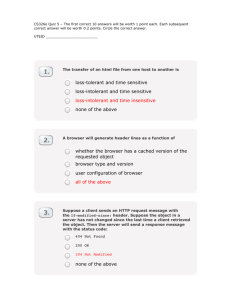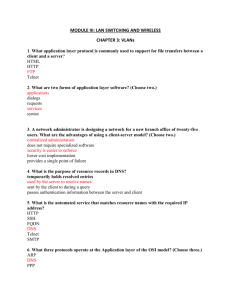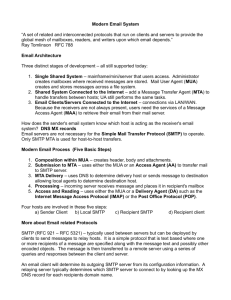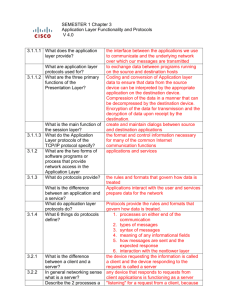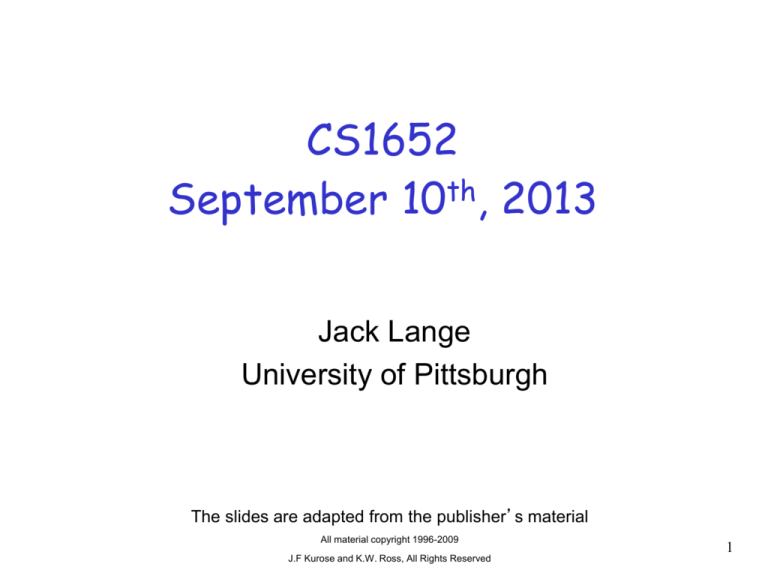
CS1652
September 10th, 2013
Jack Lange
University of Pittsburgh
The slides are adapted from the publisher’s material
All material copyright 1996-2009
J.F Kurose and K.W. Ross, All Rights Reserved
1
Electronic Mail
outgoing
message queue
user mailbox
user
agent
Three major components:
r
user agents
r
mail servers
r
simple mail transfer protocol:
SMTP
User Agent
r
a.k.a. “mail reader”
r
composing, editing, reading mail
messages
r
e.g., Eudora, Outlook, elm,
Mozilla Thunderbird
r
outgoing, incoming messages
stored on server
mail
server
user
agent
SMTP
SMTP
mail
server
SMTP
mail
server
user
agent
user
agent
user
agent
user
agent
2: Application Layer
10
Electronic Mail: mail servers
user
agent
Mail Servers
r
mailbox contains incoming
messages for user
r
message queue of outgoing
(to be sent) mail messages
r
SMTP protocol between
mail servers to send email
messages
client: sending mail
server
“server”: receiving mail
server
mail
server
user
agent
SMTP
SMTP
mail
server
SMTP
mail
server
user
agent
user
agent
user
agent
user
agent
2: Application Layer
11
Electronic Mail: SMTP [RFC 2821]
r
uses TCP to reliably transfer email message from client
to server, port 25
r
direct transfer: sending server to receiving server
r
three phases of transfer
r
handshaking (greeting)
transfer of messages
closure
command/response interaction
commands: ASCII text
response: status code and phrase
r messages must be in 7-bit ASCII
2: Application Layer
12
Scenario: Alice sends message to Bob
4) SMTP client sends Alice’s
message over the TCP
connection
1) Alice uses UA to compose
message to
bob@someschool.edu
5) Bob’s mail server places the
message in Bob’s mailbox
6) Bob invokes his user agent
to read message
2) Alice’s UA sends message
to her mail server;
message placed in message
queue
3) Client side of SMTP opens
TCP connection with Bob’s
mail server
1
user
agent
2
mail
server
mail
server
3
4
5
6
user
agent
2: Application Layer
13
Sample SMTP interaction
S:
C:
S:
C:
S:
C:
S:
C:
S:
C:
C:
C:
S:
C:
S:
220 hamburger.edu
HELO crepes.fr
250 Hello crepes.fr, pleased to meet you
MAIL FROM: <alice@crepes.fr>
250 alice@crepes.fr... Sender ok
RCPT TO: <bob@hamburger.edu>
250 bob@hamburger.edu ... Recipient ok
DATA
354 Enter mail, end with "." on a line by itself
Do you like ketchup?
How about pickles?
.
250 Message accepted for delivery
QUIT
221 hamburger.edu closing connection
2: Application Layer
14
Try SMTP interaction for yourself:
r telnet servername 25
r see 220 reply from server
r enter HELO, MAIL FROM, RCPT TO, DATA,
QUIT commands
above lets you send email without using email client
(reader)
2: Application Layer
15
SMTP: final words
r
SMTP uses persistent
connections
r
SMTP requires message
(header & body) to be in 7bit ASCII
r
SMTP server uses
CRLF.CRLF to determine
end of message
Comparison with HTTP:
HTTP: pull
r SMTP: push
r both have ASCII
command/response
interaction, status codes
r
r
HTTP: each object
encapsulated in its own
response msg
r
SMTP: multiple objects sent
in multipart msg
2: Application Layer
16
Mail access protocols
user
agent
SMTP
SMTP
sender’s mail
server
access
protocol
receiver’s mail
server
r
SMTP: delivery/storage to receiver’s server
r
Mail access protocol: retrieval from server
user
agent
POP: Post Office Protocol [RFC 1939]
• authorization (agent <-->server) and download
IMAP: Internet Mail Access Protocol [RFC 1730]
• more features (more complex)
• manipulation of stored msgs on server
HTTP: gmail, Hotmail, Yahoo! Mail, etc.
2: Application Layer
18
Domain Name System (DNS)
21
DNS: Domain Name System
Internet hosts, routers:
IP address (32 bit) used for addressing
datagrams
“name”, e.g.,
www.yahoo.com - used
by humans
Domain Name System:
distributed database
implemented in hierarchy of
many name servers
r application-layer protocol host,
routers, name servers to
communicate to resolve names
(address/name translation)
note: core Internet function,
implemented as applicationlayer protocol
r
complexity at network’s
“edge”
2: Application Layer
22
DNS
DNS services
r hostname to IP address
translation
r host aliasing
Canonical, alias names
r mail server aliasing
r load distribution
replicated Web servers: set
of IP addresses for one
canonical name
Why not centralize DNS?
r single point of failure
r traffic volume
r distant centralized
database
r maintenance
doesn’t scale!
2: Application Layer
23
Distributed, Hierarchical Database
Root DNS Servers
com DNS servers
yahoo.com
amazon.com
DNS servers DNS servers
org DNS servers
pbs.org
DNS servers
edu DNS servers
poly.edu
umass.edu
DNS serversDNS servers
Client wants IP for www.amazon.com; 1st approx:
r client queries a root server to find .com DNS server
r client queries .com DNS server to get amazon.com
DNS server
r client queries amazon.com DNS server to get IP
address for www.amazon.com
2: Application Layer
24
DNS: Root name servers
r
A.root-servers.net to M.root-servers.net
Each server is a cluster of replicated servers
Each IP is shared by many machines (e.g., IP Anycast)
r
Responsible for top-level domain NS records
r
How do we know the IP addresses of root servers?
a Verisign, Dulles, VA
c Cogent, Herndon, VA (also LA)
d U Maryland College Park, MD
g US DoD Vienna, VA
h ARL Aberdeen, MD
j Verisign, ( 21 locations)
e NASA Mt View, CA
f Internet Software C. Palo Alto,
k RIPE London (also 16 other locations)
i Autonomica, Stockholm (plus
28 other locations)
m WIDE Tokyo (also Seoul,
Paris, SF)
CA (and 36 other locations)
13 root name
servers worldwide
b USC-ISI Marina del Rey, CA
l ICANN Los Angeles, CA
2: Application Layer
25
TLD and Authoritative Servers
r Top-level domain (TLD) servers:
Responsible for com, org, net, edu, etc, and all
top-level country domains uk, fr, ca, jp.
Network Solutions maintains servers for com TLD
Educause for edu TLD
r Authoritative DNS servers:
organization’s DNS servers, providing
authoritative hostname to IP mappings for
organization’s servers (e.g., Web, mail).
can be maintained by organization or service
provider
2: Application Layer
26
Local Name Server
r does not strictly belong to hierarchy
r each ISP (residential ISP, company,
university) has one.
also called “default name server”
r when host makes DNS query, query is sent
to its local DNS server
acts as proxy, forwards query into hierarchy
2: Application Layer
27
DNS name
resolution example
root DNS server
2
r Host at
swan.cs.pitt.edu wants
IP address for
www.princeton.edu
3
TLD DNS server
4
5
local DNS server
ns1.cs.pitt.edu
iterated query:
r
r
contacted server
replies with name of
server to contact
“I don’t know this
name, but ask this
server”
1
8
requesting host
7
6
authoritative DNS server
dns.princeton.edu
swan.cs.pitt.edu
www.princeton.edu
2: Application Layer
28
root DNS server
recursive query:
r
r
2
puts burden of name
resolution on
contacted name server
heavy load?
3
7
6
TLD DNS server
local DNS server
ns1.cs.pitt.edu
1
5
4
8
requesting host
authoritative DNS server
dns.princeton.edu
swan.cs.pitt.edu
www.umass.edu
2: Application Layer
29
DNS: caching and updating records
r Once (any) name server learns mapping, it caches
mapping
cache entries timeout (disappear) after some
time
TLD servers typically cached in local name
servers
• Thus root name servers not often visited
r Typical cache hit rate: 80-90% at local DNS server
r Negative caching of DNS queries (RFC 2308)
Caches negative responses (e.g., non-existent names)
2: Application Layer
30
DNS records
DNS: distributed db storing resource records (RR)
RR format: (name,
r Type=A
name is hostname
value is IP address
value, type, ttl)
r Type=CNAME
r Type=NS
name is domain (e.g. foo.com)
value is hostname of
authoritative name server for
r
this domain
name is alias name for some
“canonical” (the real) name
www.ibm.com is really
servereast.backup2.ibm.com
value is canonical name
Type=MX
value is name of mailserver
associated with name
2: Application Layer
31
DNS protocol, messages
DNS protocol : query and reply messages, both with same message format
msg header
r
identification: 16 bit #
for query, reply to query
uses same #
r
flags:
query or reply
recursion desired
recursion available
reply is authoritative
2: Application Layer
32
DNS protocol, messages
Name, type fields
for a query
RRs in response
to query
records for
authoritative servers
additional “helpful”
info that may be used
2: Application Layer
33
Inserting records into DNS
r example: new startup “Network Utopia”
r register name networkuptopia.com at DNS registrar
(e.g., Network Solutions)
provide names, IP addresses of authoritative name server
(primary and secondary)
registrar inserts two RRs into com TLD server:
(networkutopia.com, dns1.networkutopia.com, NS)
(dns1.networkutopia.com, 212.212.212.1, A)
r create authoritative server Type A record for
www.networkuptopia.com; Type MX record for
networkutopia.com
2: Application Layer
34
Peer-to-Peer Systems
35
Pure P2P architecture
r no always-on server
r arbitrary end systems
directly communicate peer-peer
r peers are intermittently
connected and change
IP addresses
r Three topics:
File distribution
Searching for
information
Case Study: Skype
2: Application Layer
36
File Distribution: Server-Client vs P2P
Question : How much time to distribute file
from one server to N peers?
us: server upload
bandwidth
Server
us
File, size F
dN
uN
u1
d1
u2
ui: peer i upload
bandwidth
d2
di: peer i download
bandwidth
Network (with
abundant bandwidth)
2: Application Layer
37
File distribution time: server-client
Server
r server sequentially
sends N copies:
NF/us time
r client i takes F/di
time to download
Time to distribute F
to N clients using
client/server approach
F
us
dN
uN
u1 d1 u2
d2
Network (with
abundant bandwidth)
= dcs = max { NF/us, F/min(di) }
i
increases linearly in N
(for large N) 2: Application Layer
38
File distribution time: P2P
Server
r server must send one
copy: F/us time
r client i takes F/di time
to download
r NF bits must be
F
u1 d1 u2
us
dN
uN
d2
Network (with
abundant bandwidth)
downloaded (aggregate)
r fastest possible upload rate: us +
ui
dP2P = max { F/us, F/min(di) , NF/(us + ui) }
i
2: Application Layer
39
Server-client vs. P2P: example
Client upload rate = u, F/u = 1 hour, us = 10u, dmin ≥ us
2: Application Layer
40
File distribution: BitTorrent
r P2P file distribution
tracker: tracks peers
participating in torrent
torrent: group of
peers exchanging
chunks of a file
obtain list
of peers
trading
chunks
peer
2: Application Layer
41
BitTorrent (1)
r file divided into 256KB chunks.
r peer joining torrent:
has no chunks, but will accumulate them over time
registers with tracker to get list of peers,
connects to subset of peers (“neighbors”)
r while downloading, peer uploads chunks to other
peers.
r peers may come and go
r once peer has entire file, it may (selfishly) leave or
(altruistically) remain
2: Application Layer
42
BitTorrent (2)
Pulling Chunks
Sending Chunks: tit-for-tat
at any given time,
different peers have
different subsets of file
chunks
r
r
periodically, a peer (Alice)
asks each neighbor for list
of chunks that they have.
r
r
Alice sends requests for
her missing chunks
r
rarest first
Alice sends chunks to four
neighbors currently sending her
chunks at the highest rate
re-evaluate top 4 every 10 secs
every 30 secs: randomly select
another peer, starts sending
chunks
newly chosen peer may join top
4
“optimistically unchoke”
2: Application Layer
43
BitTorrent: Tit-for-tat
(1) Alice “optimistically unchokes” Bob
(2) Alice becomes one of Bob’s top-four providers; Bob reciprocates
(3) Bob becomes one of Alice’s top-four providers
With higher upload rate,
can find better trading
partners & get file faster!
2: Application Layer
44
Distributed Hash Table (DHT)
r DHT = distributed P2P database
r Database has (key, value) pairs;
key: ss number; value: human name
key: content type; value: IP address
r Peers query DB with key
DB returns values that match the key
r Peers can also insert (key, value) peers
DHT Identifiers
r Assign integer identifier to each peer in range
[0,2n-1].
Each identifier can be represented by n bits.
r Require each key to be an integer in same range.
r To get integer keys, hash original key.
eg, key = h(“Led Zeppelin IV”)
This is why they call it a distributed “hash” table
How to assign keys to peers?
r Central issue:
Assigning (key, value) pairs to peers.
r Rule: assign key to the peer that has the
closest ID.
r Convention in lecture: closest is the
immediate successor of the key.
r Ex: n=4; peers: 1,3,4,5,8,10,12,14;
key = 13, then successor peer = 14
key = 15, then successor peer = 1
Circular DHT (1)
1
3
15
4
12
5
10
8
r Each peer only aware of immediate successor
and predecessor.
r “Overlay network”
Circle DHT (2)
0001
O(N) messages
on avg to resolve
query, when there
are N peers
I am
Who’s resp
0011
for key 1110 ?
1111
1110
0100
1110
1110
1100
1110
1110
Define closest
as closest
successor
1010
1110
1000
0101
Circular DHT with Shortcuts
1
Who’s resp
3
15
for key 1110?
4
12
5
10
8
r Each peer keeps track of IP addresses of predecessor,
successor, short cuts.
r Reduced from 6 to 2 messages.
r Possible to design shortcuts so O(log N) neighbors, O(log
N) messages in query
Peer Churn
1
•To handle peer churn, require
3
15
each peer to know the IP address
of its two successors.
4
12
5
10
• Each peer periodically pings its
two successors to see if they
are still alive.
8
r Peer 5 abruptly leaves
r Peer 4 detects; makes 8 its immediate successor;
asks 8 who its immediate successor is; makes 8’s
immediate successor its second successor.
r What if peer 13 wants to join?
Chapter 2: Summary
our study of network apps now complete!
r application architectures
r specific protocols:
client-server
HTTP
P2P
FTP
hybrid
SMTP, POP, IMAP
DNS
P2P: BitTorrent, Skype
r application service
requirements:
reliability, bandwidth, delay
r socket programming
r Internet transport
service model
connection-oriented,
reliable: TCP
unreliable, datagrams: UDP
2: Application Layer
54
Chapter 2: Summary
Most importantly: learned about protocols
r typical request/reply
message exchange:
client requests info or
service
server responds with
data, status code
r message formats:
headers: fields giving
info about data
data: info being
communicated
Important themes:
r control vs. data msgs
in-band, out-of-band
r centralized vs.
decentralized
r stateless vs. stateful
r reliable vs. unreliable
msg transfer
r “complexity at network
edge”
2: Application Layer
55
P2P Case study: Skype
Skype clients (SC)
r inherently P2P: pairs
of users communicate.
r proprietary
application-layer
protocol (inferred via
reverse engineering)
Skype
login server
Supernode
(SN)
r hierarchical overlay
with SNs
r Index maps
usernames to IP
addresses;
distributed over SNs
2: Application Layer
52
Peers as relays
r Problem when both
Alice and Bob are
behind “NATs”.
NAT prevents an outside
peer from initiating a call
to insider peer
r Solution:
Using Alice’s and Bob’s
SNs, Relay is chosen
Each peer initiates
session with relay.
Peers can now
communicate through
NATs via relay
2: Application Layer
53
Mail message format
SMTP: protocol for
exchanging email msgs
header
RFC 822: standard for text
message format:
r
header lines, e.g.,
To:
From:
Subject:
blank
line
body
different from SMTP
commands!
r
body
the “message”, ASCII
characters only
2: Application Layer
17
POP3 protocol
authorization phase
r
r
client commands:
user: declare username
pass: password
server responses
+OK
-ERR
transaction phase, client:
r
list: list message numbers
r
retr: retrieve message by
number
r
dele: delete
r
quit
S:
C:
S:
C:
S:
+OK POP3 server ready
user bob
+OK
pass hungry
+OK user successfully logged
C:
S:
S:
S:
C:
S:
S:
C:
C:
S:
S:
C:
C:
S:
list
1 498
2 912
.
retr 1
<message 1 contents>
.
dele 1
retr 2
<message 1 contents>
.
dele 2
quit
+OK POP3 server signing off
2: Application Layer
on
19
POP3 (more) and IMAP
More about POP3
r
Previous example uses
“download and delete”
mode.
r
Bob cannot re-read e-mail
if he changes client
r
“Download-and-keep”:
copies of messages on
different clients
r
POP3 is stateless across
sessions
IMAP
r Keep all messages in
one place: the server
r Allows user to organize
messages in folders
r IMAP keeps user state
across sessions:
names of folders and
mappings between message
IDs and folder name
2: Application Layer
20

